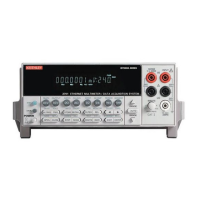Model 2701 User’s Manual Measurement Considerations E-5
Source resistance noise
Noise present in the source resistance is often the limiting factor in the ultimate resolution
and accuracy of Model 2701 measurements. The following paragraphs discuss the
generation of Johnson noise as well as ways to minimize such noise.
Johnson noise equation
The amount of noise present in a given resistance is defined by the Johnson noise equation
as follows:
where: E
RMS
= rms value of the noise voltage
k = Boltzmann's constant (1.38 × 10
–23
J/K)
T = Temperature (K)
R = Source resistance (ohms)
F = Noise bandwidth (Hz)
At a room temperature of 293K (20°C), the above equation simplifies to:
Since the peak to peak noise is five times the rms value 99% of the time, the peak to peak
noise can be equated as follows:
For example, with a source resistance of 10kΩ, the noise over a 0.5Hz bandwidth at room
temperature will be:
Minimizing source resistance noise
From the above examples, it is obvious that noise can be reduced in several ways: (1)
lower the temperature, (2) reduce the source resistance, and (3) narrow the bandwidth. Of
these three, lowering the resistance is the least practical because the signal voltage will be
reduced more than the noise. For example, decreasing the resistance of a current shunt by
a factor of 100 will also reduce the voltage by a factor of 100, but the noise will be
decreased only by a factor of 10.
Very often, cooling the source is the only practical method available to reduce noise.
Again, however, the available reduction is not as large as it might seem because the
reduction is related to the square root of the change in temperature. For example, to cut the
noise in half, the temperature must be decreased from 293K to 73.25K, a four-fold
decrease.
E
RMS
4kTRF=
E
RMS
1.27 10
10–
× RF=
E
pp–
6.35 10
10–
× RF=
E
pp–
6.35 10
10–
× 10 10
3
×()0.5()=
E
pp–
45nV=

